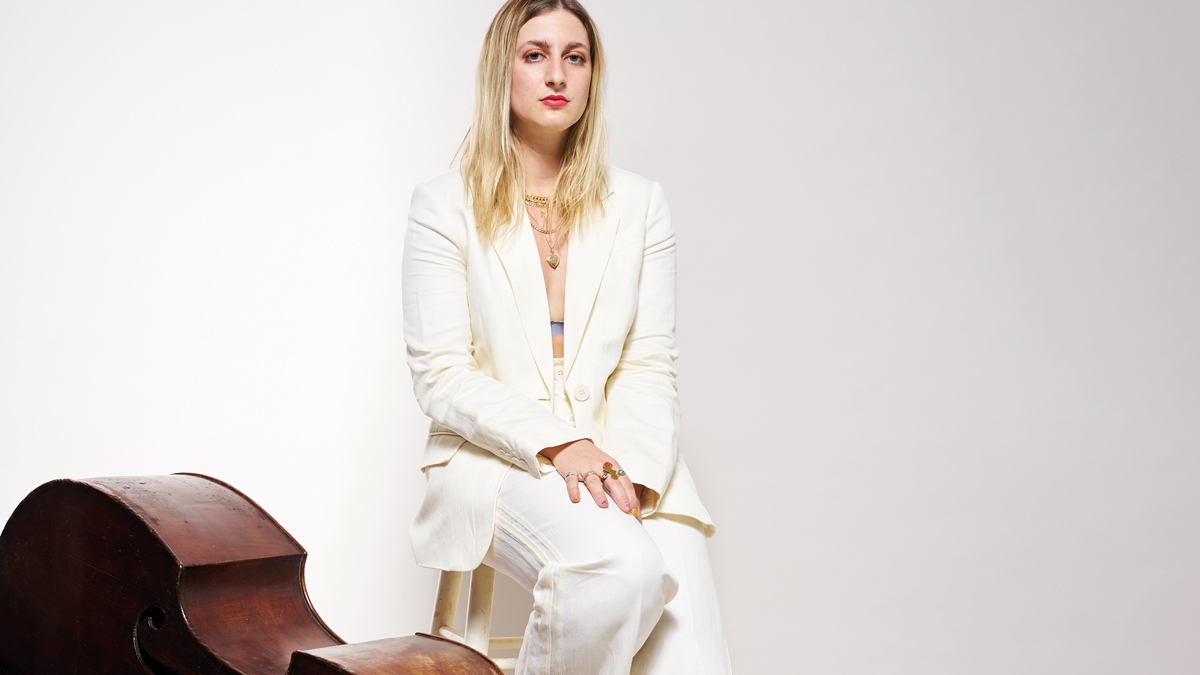Adi Meyerson on taking inspiration from avant garde artist Yayoi Kusama and processing synesthesia through bass
The upright bassist returns with a new compositional style inspired by visual arts and synesthesia, and explains her method for us

Brought up in Israel and resident in New York City, bassist Adi Meyerson released a well-received jazz album called Where We Stand in 2018, but takes a different inspiration for its follow-up, I Want To Sing My Heart Out In Praise Of Life.
It’s a six-part collection inspired by the work of the avant-garde visual artist Yayoi Kusama, a recent exhibition of whose work suggested songwriting themes to Meyerson.
The songs, as the bassist tells us, were inspired in part by her experience of synesthesia, a neurological condition in which the human senses overlap: In Meyerson’s case, she sees colors when she hears certain pitches, making Kasama’s artwork a musical as well as visual experience.
Tell us about your new album, Adi.
“I finished writing most of it right before the pandemic, literally in February of 2020. I applied for funding for the album from the New York Foundation Of The Arts in October of 2019, and then got the notification that I received funding for it in the first week of March. A week later, everything shut down.”
Are you pleased with the way it turned out?
“I’m really proud of it: It’s my best music to date, I think. It definitely took a lot of work, but I’m very proud of this album and how it came out. It’s one of the most honest representations of music, as far as who I am as an artist, that I’ve done.
Get The Pick Newsletter
All the latest guitar news, interviews, lessons, reviews, deals and more, direct to your inbox!
“It’s definitely very different than my last album, which was a lot more traditional swing and jazz. This one’s more on the free side: a lot of the compositions are inspired by Ornette Coleman, with counterpoint lines and so on.”
What was the role of your synesthesia?
“I guess it’s a condition that I always had, but it was only when I went to college and said something about it to a professor, who was like, ‘What are you talking about?’ that I did some research into it and realized, ‘Oh, this is a thing that not a lot of people have’.
“The album was born from a Yayoi Kusama exhibition that I saw in New York. It struck me, on seeing her paintings, that a lot of the colors that she uses were very similar to the colors I was seeing in my head, which are hard to describe because it’s such a vague, broad thing. It’s not like a regular green or something.
“This planted the idea in my head to write music inspired by that experience, and then a few years later, when I was in grad school, one of the assignments that I was given was to write a suite of music that was inspired by another art form. I was like, ‘I always wanted to do this. Let me try this,’ and I started using the pitch material, matching the colors to the notes. Since then, it’s changed and developed a lot, but that was the core of it.”
So what does synesthesia actually feel like for those who experience it?
“It’s a visual thing for me. Each pitch has a color. You play a chord, and I can see colors and maybe I’ll say, ‘That’s yellow, green, blue, and purple’ and it will actually be E, G, C, and D. If you flatten those notes or sharpen them and mess around with it, the colors can change.
“It works with letters, numbers, and pitches on paper too – so when I see sheet music, I see it as colorful, in a way. I’ve read [the late psychologist] Oliver Sacks’ book Musicophilia, and he has a whole chapter about synesthesia and how it can manifest for different people in different ways.It can come through as taste, for example. It’s been cool to meet other musicians that also have it.”
Talk to us about your bass guitars.
“Three years ago I bought my first fully carved bass ever. I went to go fix my plywood bass, and I found this bass in the shop and played it – and that was it. That was my baby. It has a C extension, which is cool, and a flat back. It has a little shorter-scale neck. I want to say it has some kind of Eastern European origin: the appraiser said it was about 100 years old, but there’s no maker’s mark or anything on it. It sounds really good, and I love it.”
Any effects on the bass?
“No, but on one song the piano player is doubling the bassline, and there’s one song where I’m using some extended technique bow sounds, which make the bass sound like an electronic synth, but it’s all just done with the bow. That’s about it.
“For gigs I play that are more on the pop side, I play electric bass. I have a Fender Mustang and Aguilar gear for those. I’ve also recently started playing a five-string Callowhill that belongs to a friend of mine. I’ve been exploring it, and I love the way it sounds.”
Is that pop music your own music?
“Some of it is my own music, but it hasn’t come out yet. I’ve been exploring that side of things a little bit and freelancing with a bunch of different artists – pop, soul, R&B, whatever. Honestly, if your music is inspiring and fun, then I’ll play it.”
So many of the greatest musicians are in New York, as well as the greatest teachers in history. I wanted to explore that
How did you get into bass?
“I started on electric bass when I was about 14. I was at an art school in Jerusalem, because I actually started as a visual artist – I paint as well as play music. I always wanted to play an instrument, and when I was in art school, we took general music classes, and I started hanging out with the music people and getting into it.
“They didn’t have a bass player, so I was like, ‘Maybe I’ll try the bass.’ I had some money saved up, so I bought a little electric bass. I fell in love with it, and ended up transferring to the music department in the school. I got serious about it after I graduated high school. I started getting into jazz, and listening to jazz records, and we moved to Tel Aviv, where I went to school for a couple of years before moving to New York three years later.”
Why make the move to New York?
“So many of the greatest musicians are in New York, as well as the greatest teachers in history. I wanted to explore that, so I studied at the New School with Reggie Workman and Bob Cranshaw. Johannes Weidenmueller and Reuben Rogers were some of my first bass teachers in the city. And then later on, I had the privilege of studying with Mr. Ron Carter. That’s why I moved to New York, because all these people were here: My musical heroes.”
What was the most important lesson that Ron Carter taught you?
“Oh, there’s so many. Maybe that there are no bad notes – that was a good one – but he really helped me get my technique together and learn the instrument from the inside. He taught me the importance of discipline, which was really useful because I never really had a teacher that did that with me before him. I’m grateful for all the lessons and all the time I got to spend with him.”
Why did you title the new album I Want To Sing My Heart Out In Praise Of Life?
“That that’s the name of a Kusama painting that really spoke to me, but it’s also because of the way the album developed. It started with the idea that I wanted to write music based on her artwork, but then I read more about her life and her struggle with mental health, and her struggle as a woman.
“She came to New York City in the '60s and was active around the same time as Andy Warhol, but she really didn’t get famous until later in life: She’s in her 90s now. In her prime, when she was innovating all these things, she wasn’t getting enough credit for what she was doing.
“With everything that’s going on in the world right now, and with my own struggles as an artist and a person, that title really resonated with me, because we’re here, and we’re living. We’re dealing with a lot of things, but also we’re happy to be alive, and we’re grateful. So the whole concept of the album is really about trying to find something positive to leave to the world, so people can listen and be in this utopian sonic space for 40 minutes.
“That’s what Kusama’s idea was with some of these artworks – her view was that this is how the world is, so she was going to create a world where she could function and where we can function too, because we can’t function in the normal world. So that was the idea with this album. I’m hoping people will like it. I would like them to listen to it from beginning to end. I’m really excited for people to hear it.”
- I Want To Sing My Heart Out In Praise Of Life is out now via Bandcamp.
Bass Player is the world’s most comprehensive, trusted and insightful bass publication for passionate bassists and active musicians of all ages. Whatever your ability, BP has the interviews, reviews and lessons that will make you a better bass player. We go behind the scenes with bass manufacturers, ask a stellar crew of bass players for their advice, and bring you insights into pretty much every style of bass playing that exists, from reggae to jazz to metal and beyond. The gear we review ranges from the affordable to the upmarket and we maximise the opportunity to evolve our playing with the best teachers on the planet.
“I asked him to get me four bass strings because I only had a $29 guitar from Sears”: Bootsy Collins is one of the all-time bass greats, but he started out on guitar. Here’s the sole reason why he switched
“I got that bass for $50 off this coke dealer. I don’t know what Jaco did to it, but he totally messed up the insides!” How Cro-Mags’ Harley Flanagan went from buying a Jaco Pastorius bass on the street to fronting one of hardcore’s most influential bands











